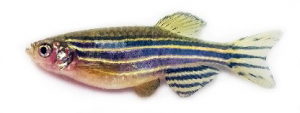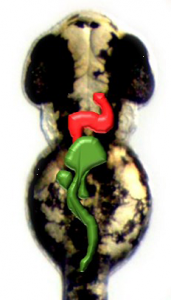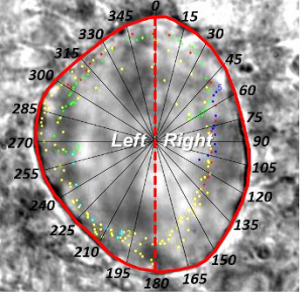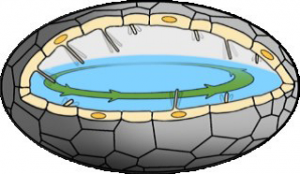Postdoc/PhD position at the Institut de Biologie Valrose
Nice, FRANCE
Functional analysis of Myosin 1C/D in Zebrafish Left/Right asymmetry
 The team of Maximilian Fürthauer at the Institut de Biologie Valrose in Nice (http://ibv.unice.fr/EN/equipe/furthauer.php) is looking for a highly motivated doctoral or postdoctoral research fellow to study the role of MyosinI proteins in establishing zebrafish Left/Right asymmetry.
The team of Maximilian Fürthauer at the Institut de Biologie Valrose in Nice (http://ibv.unice.fr/EN/equipe/furthauer.php) is looking for a highly motivated doctoral or postdoctoral research fellow to study the role of MyosinI proteins in establishing zebrafish Left/Right asymmetry.
 While well conserved molecular pathways govern antero-posterior and dorso-ventral patterning in different phyla, highly divergent mechanisms have been proposed to be responsible for the specification of Left/Right asymmetry in different organisms. A cilia-driven, directional fluid flow is important for symmetry breaking in numerous vertebrates, including zebrafish. Alternatively, cilia-independent mechanisms have been suggested to involve localized ion flows or directional cellular rearrangements dependent on cytoskeletal polarity. This raises the question whether a unifying mechanism controlling Left/Right asymmetry still remains to be identified? An attractive hypothesis is that cytoskeletal chirality may provide a template for organismal laterality.
While well conserved molecular pathways govern antero-posterior and dorso-ventral patterning in different phyla, highly divergent mechanisms have been proposed to be responsible for the specification of Left/Right asymmetry in different organisms. A cilia-driven, directional fluid flow is important for symmetry breaking in numerous vertebrates, including zebrafish. Alternatively, cilia-independent mechanisms have been suggested to involve localized ion flows or directional cellular rearrangements dependent on cytoskeletal polarity. This raises the question whether a unifying mechanism controlling Left/Right asymmetry still remains to be identified? An attractive hypothesis is that cytoskeletal chirality may provide a template for organismal laterality.
 In Drosophila, the actin-binding molecular motor protein Myosin 1D (Myo1D) acts as an essential determinant of Left/Right asymmetry. Myo1D is itself negatively regulated by Myosin 1C (Myo1C), establishing the Myosin 1C/D system as a central regulator of Left/Right asymmetry in flies. The objective of this project at the interface between cellular and developmental biology is to dissect the contribution of the Myosin 1C/D system to the establishment of zebrafish Left/Right asymmetry. This work will be performed in the context of a highly active ANR-funded collaboration with the lab of Stéphane Noselli, who has pioneered the study of Myo1D in Drosophila Left/Right asymmetry.
In Drosophila, the actin-binding molecular motor protein Myosin 1D (Myo1D) acts as an essential determinant of Left/Right asymmetry. Myo1D is itself negatively regulated by Myosin 1C (Myo1C), establishing the Myosin 1C/D system as a central regulator of Left/Right asymmetry in flies. The objective of this project at the interface between cellular and developmental biology is to dissect the contribution of the Myosin 1C/D system to the establishment of zebrafish Left/Right asymmetry. This work will be performed in the context of a highly active ANR-funded collaboration with the lab of Stéphane Noselli, who has pioneered the study of Myo1D in Drosophila Left/Right asymmetry.
 Our project aims to determine the function of Myosin 1C/D, its spatial and temporal requirements, identify its partners and targets. The interaction of the Myosin 1C/D system with known Left/Right pathways (nodal, cilia, actin cytoskeleton) will be studied, leading to an integrated model of the establishment of Left/Right. The candidate will greatly benefit from different tools that the Fürthauer lab has already established to study different aspects Left/Right asymmetry and manipulate Zebrafish Myosin 1C/D function.
Our project aims to determine the function of Myosin 1C/D, its spatial and temporal requirements, identify its partners and targets. The interaction of the Myosin 1C/D system with known Left/Right pathways (nodal, cilia, actin cytoskeleton) will be studied, leading to an integrated model of the establishment of Left/Right. The candidate will greatly benefit from different tools that the Fürthauer lab has already established to study different aspects Left/Right asymmetry and manipulate Zebrafish Myosin 1C/D function.
We particularly encourage applications by candidates with expertise in developmental or cellular biology that are motivated to apply quantitative approaches to the image-based analysis of biological processes.
 Contact information
Contact information
Candidates should send their CV, a description of their scientific achievements and the contacts of two referees to Maximilian Fürthauer (furthauer@unice.fr).
